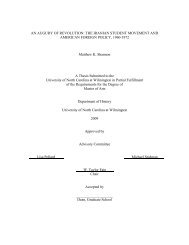HIERARCHAL INDUCTIVE PROCESS MODELING AND ANALYSIS ...
HIERARCHAL INDUCTIVE PROCESS MODELING AND ANALYSIS ...
HIERARCHAL INDUCTIVE PROCESS MODELING AND ANALYSIS ...
You also want an ePaper? Increase the reach of your titles
YUMPU automatically turns print PDFs into web optimized ePapers that Google loves.
4.4 Model B<br />
Shifting our focus to Model B we find different model structures. Indeed, (7) yields<br />
a Lokta-Volterra structure which will make for an interesting analysis.<br />
Following the procedure used for Model A, we start our analysis with the Zooplankton<br />
equation (7), the simplest of all five. To find bounds for Z(t) we first need<br />
to find that of H(t).<br />
{<br />
}<br />
a 13 (P − a 16 − a 15 )<br />
H(t) =max 0,<br />
a 14 + (P − a 16 − a 15 )<br />
a 13 (P − a 16 − a 15 )<br />
a 14 + (P − a 16 − a 15 ) ≤ a 13<br />
Thus we get,<br />
0 ≤ H(t) < a 13 (22)<br />
Knowing (22) we can conclude,<br />
dZ<br />
( )<br />
dt = a 12 H(t)Z − a 11 Z 2 − a 18 Z<br />
≤a 12 a 13 Z − a 11 Z 2 − a 18 Z = Z [a 12 a 13 − a 18 − a 11 Z]<br />
} {{ }<br />
Logistic Equation<br />
Setting, a 12 a 13 − a 18 − a 11 Z = 0 we can find the carrying capacity K.<br />
K = a 12a 13 − a 18<br />
a 12<br />
= 42.3156486<br />
48
















